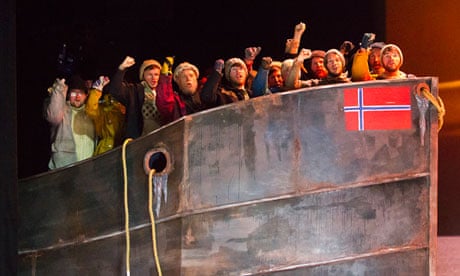Using a simple three-note roar and plenty of fortissimo orchestral crashes, Wagner whips up harsh weather and bleak seas in the overture to The Flying Dutchman. A storm is an archetypal operatic image to herald turbulence in the hearts of a story's protagonists. In NI Opera's first Wagner production, described as "the first fully staged Dutchman to be seen in Northern Ireland for generations", there was no certainty as to how this theatrical voyage would unfold.
At first all seemed traditional: a dark seascape, frozen tundra, two ships, one Dutchman (Bruno Caproni), wearing the weather-beaten black overcoat and scowl that all Dutchmen – at least those condemned to sail the high seas for seven years at a time in search of a good woman – tend to wear. The singing was accomplished, the orchestra rising to the challenge under the baton of Nicholas Chalmers. By the end of Act I – this was the extended, three-act version – you might have summed this up as a sturdy effort from a company barely two years old.
After the interval all changed. Oliver Mears, director, and designer Simon Holdsworth transported us from the Norwegian coastline of Wagner's original to the heart of Northern Ireland in the 1970s, the atmosphere so suffocating you could almost smell the beeswax and talc. The women delivered their Spinning Song in a neo-gothic institution, perhaps a school or college, or the shirt factory recreated by Frank McGuinness in his play The Factory Girls. Their repressed lives are governed by men – priest, father, lover. When Senta (Giselle Allen), one of their own, yields voraciously to the strange Dutchman, they watch with shock, fascination and envy.
Most of the singers were born locally and have careers outside Ireland. Caproni, from County Down, played the Dutchman as perpetually staring and wild-eyed. Vocally he was commanding if unvaried, a convincing approach to an elusive role. Paul McNamara as the spurned Erik, Stephen Richardson (the dogged sea-captain Daland), Doreen Curran (a severe Mary) and Adrian Dwyer (the sleepy young Steersman) brought individuality to their roles, though collectively there were a few vocal blips. Best of all was the excellent, well-choreographed, extremely youthful chorus – some of the men had grown beards especially, to add salty gravitas. Chalmers and the Ulster Orchestra grew more confident as the performance unfurled. It proved electrifying. Old myths return with new truths.
The recent surge of musical activity in the province continues. Regular NI collaborator Conor Mitchell (whose Ten Plagues opens at Wilton's Music Hall in London in April), has already written works related to Belfast's recent history. Now Spark, a tiny and enterprising opera company, plan to premiere his The Headless Soldier in Derry's Ebrington Barracks, a former British army base, as part of Derry-Londonderry City of Culture. Spark also has ambitions for a cross-community production of Meyerbeer's Les Huguenots, which is rarely seen and requires a cast of hundreds. Since the plot is about Catholics, Protestants and the St Bartholomew's Day massacre of 1572, it's a hot topic. Watch this space.
In Greek tragedy, the lingering death of Creusa, daughter of the king of Corinth, is one of the most lurid. She is consumed by her own dress, its fabric poisoned by her rival, Medea. Creusa's gorgeous gown "ate into her sweet flesh", her eyes melted, blood leaked from her head and her body melted like tallow, as Euripides nicely puts it. Katherine Manley conveyed this with frightening spasms and shrieks, while still singing beautifully, in the closing scene of Charpentier's Medea (1693) in David McVicar's new production for English National Opera.
The climactic finale was a long time coming, but we were distracted, most of the time, by a handsome if anachronistic staging. It might do just as well for Der Rosenkavalier. Allied forces gathered in a mirrored baroque palace at the end of the second world war, in dress uniforms or couture gowns or aviator fatigues. It could scarcely have looked more stunning or, occasional technical hitches and bumpy translation aside, have been better executed.
But the "concept" – that ancillary muse invoked so often by directors faced with repertoire remote and difficult for most audiences – cannot always provide the hoped for intercession. Charpentier's music is not hard to enjoy, its moment-by-moment bursts of ingenuity stitched together like tiny, brilliant sequins. Yet it is difficult to navigate across three and a half hours, especially when the scale of the concept, so stiff and massive, runs counter to the infinitely varied structure of the music, which ends up much of the time sounding dull.

The delicate colours of theorbos, viola da gamba, harpsichord and recorders are swallowed up in the cavernous Coliseum but still managed to sound sensuous. All the orchestral playing was expert, with Christian Curnyn, conducting, an inspired guide. Jeffrey Francis as Jason, with Brindley Sherratt (Creon), Roderick Williams (Orontes), Rhian Lois (Nerina) and Aoife O'Sullivan (Cleonis), headed a top cast. All told, Charpentier fans have been well served.
Even the reluctant should make the effort to go, because there is one performance of incomparable power: Sarah Connolly in the title role. At once terrifying, pathetic and noble, a human storm in sharp suit and red hair, she may kill her children and disgust her lover, but the rest of us remain faithfully dazed by her charms.

Comments (…)
Sign in or create your Guardian account to join the discussion